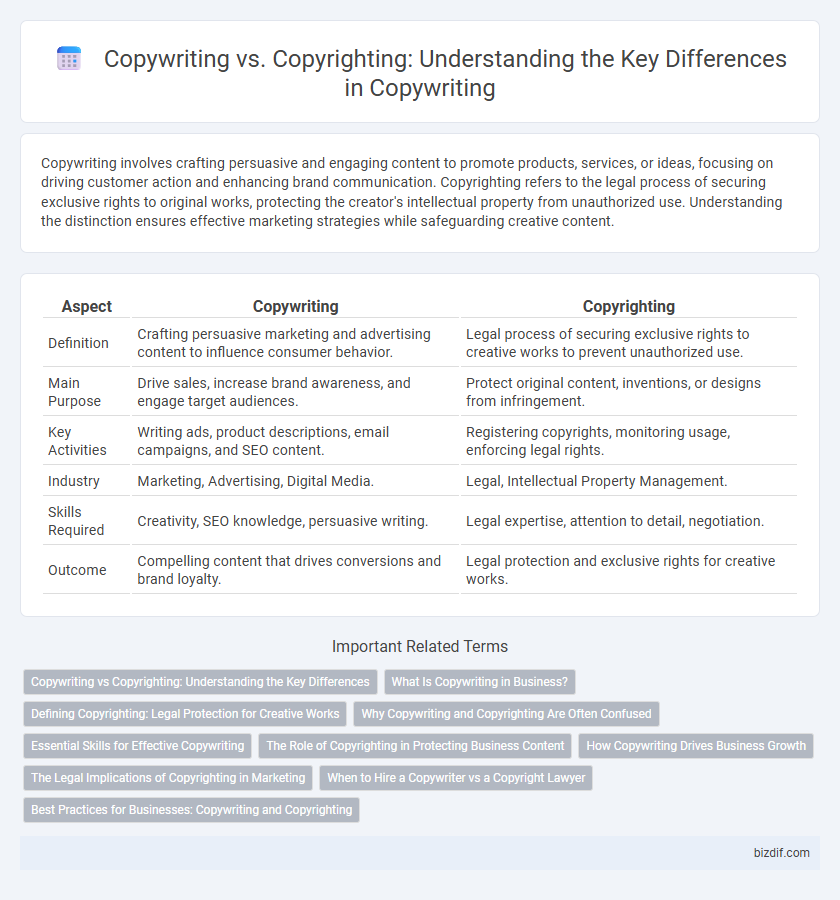Copywriting involves crafting persuasive and engaging content to promote products, services, or ideas, focusing on driving customer action and enhancing brand communication. Copyrighting refers to the legal process of securing exclusive rights to original works, protecting the creator's intellectual property from unauthorized use. Understanding the distinction ensures effective marketing strategies while safeguarding creative content.
Table of Comparison
| Aspect | Copywriting | Copyrighting |
|---|---|---|
| Definition | Crafting persuasive marketing and advertising content to influence consumer behavior. | Legal process of securing exclusive rights to creative works to prevent unauthorized use. |
| Main Purpose | Drive sales, increase brand awareness, and engage target audiences. | Protect original content, inventions, or designs from infringement. |
| Key Activities | Writing ads, product descriptions, email campaigns, and SEO content. | Registering copyrights, monitoring usage, enforcing legal rights. |
| Industry | Marketing, Advertising, Digital Media. | Legal, Intellectual Property Management. |
| Skills Required | Creativity, SEO knowledge, persuasive writing. | Legal expertise, attention to detail, negotiation. |
| Outcome | Compelling content that drives conversions and brand loyalty. | Legal protection and exclusive rights for creative works. |
Copywriting vs Copyrighting: Understanding the Key Differences
Copywriting involves crafting persuasive and engaging text aimed at marketing products or services, while copyrighting pertains to securing legal rights for original creative works. Copywriting focuses on communication strategies to boost sales and brand awareness, whereas copyrighting ensures protection against unauthorized use or reproduction of content. Understanding these distinctions helps businesses effectively create compelling messages and safeguard intellectual property.
What Is Copywriting in Business?
Copywriting in business involves crafting persuasive and targeted content designed to engage potential customers, promote products or services, and drive sales. It requires understanding consumer psychology, brand voice, and marketing strategies to create compelling messages across various platforms such as websites, advertisements, and social media. Unlike copyrighting, which deals with legal rights and content protection, copywriting focuses on creative writing aimed at influencing and converting audiences.
Defining Copyrighting: Legal Protection for Creative Works
Copyrighting involves securing legal protection for original creative works, ensuring authors retain exclusive rights to reproduce, distribute, and display their content. This legal framework safeguards literary, artistic, musical, and digital creations from unauthorized use, providing creators with control over their intellectual property. Understanding copyrighting is crucial for protecting creative assets and preventing infringement in various media industries.
Why Copywriting and Copyrighting Are Often Confused
Copywriting and copyrighting are often confused due to their similar spelling and pronunciation, yet they represent distinctly different fields; copywriting involves crafting persuasive marketing content, while copyrighting pertains to legal rights protecting original works. Many people mistakenly interchange these terms because both relate to text and intellectual property, causing ambiguity in understanding their specific roles. Clear differentiation is essential for businesses and creatives to ensure proper application of marketing strategies versus legal protection.
Essential Skills for Effective Copywriting
Effective copywriting requires mastery of persuasive language, audience analysis, and clear messaging to drive engagement and conversions. Unlike copyrighting, which involves legal rights protection, copywriting centers on crafting compelling content that resonates with target readers. Essential skills include strong writing ability, creativity, and understanding marketing principles to create impactful promotional materials.
The Role of Copyrighting in Protecting Business Content
Copyrighting plays a crucial role in protecting business content by legally securing original creations such as written text, logos, and marketing materials. This protection prevents unauthorized use or reproduction, ensuring that a company's intellectual property and brand identity remain exclusive. Businesses leverage copyrighting to maintain competitive advantage and uphold the legal rights of their creative assets.
How Copywriting Drives Business Growth
Copywriting drives business growth by crafting persuasive and engaging content that attracts and converts potential customers, boosting sales and brand loyalty. Effective copywriting strategically targets audience needs and emotions, enhancing marketing campaigns and increasing conversion rates. Unlike copyrighting, which protects intellectual property, copywriting focuses on communication that motivates action and builds long-term customer relationships.
The Legal Implications of Copyrighting in Marketing
Copyrighting in marketing protects original content by granting legal rights to creators, preventing unauthorized use or reproduction. Understanding these legal implications safeguards brands from infringement lawsuits and ensures compliance with intellectual property laws. Effective copyrighting supports marketers in maintaining ownership and exclusive distribution rights over their creative materials.
When to Hire a Copywriter vs a Copyright Lawyer
Hire a copywriter when you need persuasive and engaging content that drives sales, boosts SEO, or enhances your brand voice across marketing materials. Choose a copyright lawyer to protect your intellectual property, handle legal disputes, or secure copyright registrations for your creative works. Understanding these distinct roles ensures effective communication and legal protection tailored to your business needs.
Best Practices for Businesses: Copywriting and Copyrighting
Effective copywriting drives business growth by crafting persuasive, targeted messages that engage audiences and boost conversions. Copyrighting ensures legal protection of original content, preventing unauthorized use and safeguarding intellectual property. Businesses combining strategic copywriting techniques with diligent copyrighting compliance maximize both marketing impact and content security.
Copywriting vs Copyrighting Infographic

 bizdif.com
bizdif.com